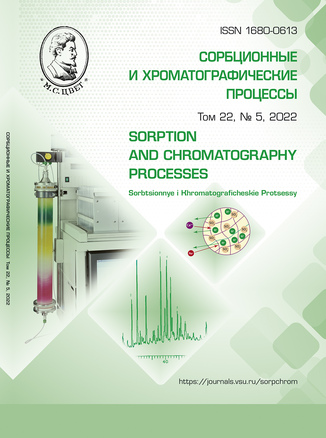Activation energies of ion exchange processes
Abstract
The temperature dependences of the electrical conductivity of MK-41 heterogeneous cation-exchange membranes and MA-41 anion-exchange membranes in the form of ions of different charges were measured by the contact-difference method. The measurements were carried out in the temperature range of 20-50оС and exponentially increasing dependences of electrical conductivity on temperature were obtained. The activation energies were calculated based on the measured values using the Arrhenius equation.
For the calculation of the activation energies, we assumed that they are the sum of the energy of the Coulomb interaction of counterions with fixed ions and the energy of breaking hydrogen bonds formed by hydrated water molecules of counterions and fixed ions. The breaking energies of hydrogen bonds were calculated using non-empirical method of quantum chemistry and by Planck equation for the bending vibrations of the water molecule. The electrostatic interaction of counterions and fixed ions was calculated using the integral form of Coulomb's law. The results of quantum chemical calculations were used for the calculation of the distances between fixed ions and counterions, the effective values of the charges of the ions, and Debye’s theory of polar molecules was used for the calculation of permittivity. The analysis of the obtained results showed that, in the case of ion exchange of singly charged ions, the factor determining the values of activation energies is the energy of breaking hydrogen bonds. It was established that as the charges of counterions increased, the Coulomb interaction of counterions and fixed ions increased, and for triply charged ions, the values of the Coulomb interaction energies were comparable with the energies of breaking hydrogen bonds. The calculated activation energies were in satisfactory agreement with the experimental results.
Downloads
References
Arrhenius S. Űber die Reactionsgeschwidigkeit bei der Inversion von Rohrzucher durch Säuren. Zeitschrift fur Physikalische Chemie. 1889; 4; 226.
Puri R.P., Duke F.R., Lomnes J. Electrical Conductance Studies on an Ion Exchange Resin. Iowa State College Journal of Science. 1956; 31(1): 25-31.
Nikolaev N.I. Diffusion in membranes. M. Khimia. 1980. 232 p.
Volkov V.I., Chernyak A.V. Molecular and Ionic Diffusion in Ion Ion Exchange Membranes and Biological Systems (Cells and Proteins) Studied by NMR. Membranes. 2021; 11: 1-71.
Kokotov Yu.A., Pasechnik V.A. Equilibrium and kinetics of ion exchange. L.: Khimia 1970. 336 p.
Badessa T.S., Shaposhnik V.A. Electrical Conductance on Ion Exchange Membrane using Contact-Difference Method. Electrochimica Acta. 2017.; 231: 453-459.
Pauley J.I. Prediction on of Cation-exchange Equilibria. J. Amer. Chem. Soc. 1954; 76: 1422-1425.
Debye P. Polar molecules. N.Y. 1929. 247 p.
Shaposhnik V.A., Butyrskaya E.V. Computer modeling of the structure of the cation exchange membrane and the elementary act of transport of hydrated ions. Russian Journal of Electrochemistry. 2004; 40(7): 880-883.
Eisenberg H., Kauzmann W. Structure and properties of water. L.: Hydrometeoizdat. 1975. 280 p.
Shakhparonov M.I. Mechanisms of fast processes in liquids. M.: Higher School. 1980. 352 p.
Shaposhnik V.A. Diffusion and electrical conductivity in aqueous solutions of strong electrolytes. Russian Journal of Electrochemistry. 1994; 30(5): 638-643.
Dolgonosov A.M. To the discussion on the nature of selectivity of strong ionites. Sorbtsionnye I khromatograficheskiye protsessy. 2021; 21(4): 606-609. https://doi.org/10.17308/sorpchrom.2021.21/3646 (In Russ.)







